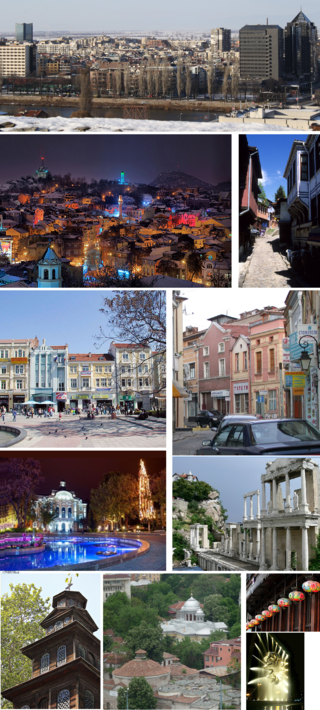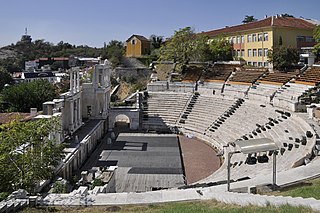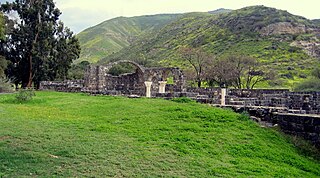
A synagogue, also called a shul or a temple, is a place of worship for Jews and Samaritans. It has a place for prayer where Jews attend religious services or special ceremonies such as weddings, bar and bat mitzvahs, choir performances, and children's plays. They also have rooms for study, social halls, administrative and charitable offices, classrooms for religious and Hebrew studies, and many places to sit and congregate. They often display commemorative, historic, or modern artwork alongside items of Jewish historical significance or history about the synagogue itself.

In Ancient Roman architecture, a basilica was a large public building with multiple functions that was typically built alongside the town's forum. The basilica was in the Latin West equivalent to a stoa in the Greek East. The building gave its name to the basilica architectural form.

Plovdiv is the second-largest city in Bulgaria, 93 miles southeast of the capital Sofia. It had a population of 346,893 as of 2018 and 675,000 in the greater metropolitan area. Plovdiv is a cultural hub in Bulgaria and was the European Capital of Culture in 2019. The city is an important economic, transport, cultural, and educational centre. Plovdiv joined the UNESCO Global Network of Learning Cities in 2016.

The Jericho synagogue dates to the late 6th or early 7th century CE and was discovered in Jericho in 1936. All that remains from the ancient prayer house is its mosaic floor, which contains an Aramaic inscription presenting thanks to the synagogue donors, and a well-preserved central medallion with the inscription "Shalom al Israel", meaning "Peace [up]on Israel". This led to the site also being known as Shalom Al Israel Synagogue.

The Roman theatre of Philippopolis is one of the world's best-preserved ancient Roman theatres, located in the city center of modern Plovdiv, Bulgaria, once the ancient city of Philippopolis. It was constructed in the 1st century AD, probably during the reign of Domitian. The theatre can host between 5,000 and 7,000 spectators and it is currently in use.

The Stadiumof Philippopolis was the ancient Roman stadium of Philippopolis, built in the 2nd century AD, during the Roman imperial period. It is among the largest and best preserved buildings from the time of the Roman Empire in the Balkan peninsula. At the time the stadium was built, Philippopolis was the capital of the Roman province of Thracia.

Kursi is an archaeological site in the Golan Heights containing the ruins of a Byzantine monastery and identified by tradition as the site of Jesus' "Miracle of the Swine". Part of the archaeological site is now an Israeli national park. Kursi takes its name from the Talmudic site. A marble slab with Aramaic text discovered in December 2015 seems to indicate that the settlement had, as of c. 500 CE, a Jewish or Judeo-Christian population.

The Great Mosque of Gaza, also known as the Great Omari Mosque, was the largest and oldest mosque in all of Gaza, Palestine, located in Gaza City.

Historic synagogues include synagogues that date back to ancient times and synagogues that represent the earliest Jewish presence in cities around the world. Some synagogues were destroyed and rebuilt several times on the same site. Others were converted into churches and mosques or used for other purposes.

Tzippori Synagogue is an ancient synagogue discovered in Sepphoris, a Roman-era Jewish city in the Galilee, now an archaeological site and a national park in Israel.

The Maon Synagogue is a 6th-century synagogue and archaeological site located in the Negev Desert near Kibbutz Nirim and Kibbutz Nir Oz. It is noted for its "magnificent" mosaic floor.

Hammath Tiberias or Hammat Tiberias is an ancient archaeological site and an Israeli national park known as Hamat Tverya National Park, which is located on the adjacent to Tiberias on the road to Zemach that runs along the shore of the Sea of Galilee.
The Bova Marina Synagogue, located in Bova Marina, Calabria, is the second oldest synagogue uncovered in Italy and one of the oldest in Europe, dating back to the 4th century CE.

The Plovdiv Synagogue, officially the Zion Plovdiv Synagogue, is a Romaniote Jewish congregation and synagogue, located in the city of Plovdiv, Bulgaria. Built in 1892, the synagogue is one of the two active remaining synagogues in Bulgaria. The congregation worships in the Sephardi rite.

The Small Basilica of Philippopolis is one of Plovdiv's most distinctive landmarks. The basilica is located on Maria Louisa Blvd in the central part of Bulgaria's second-largest city. The ruins of the early Christian church were found during construction works in the area in 1988. The three-nave basilica is an example of the exceptional skill of mosaic builders in ancient Philippopolis.

Philippopolis is one of the names of the ancient city situated where Plovdiv is today. The city became one of the largest and most important in the region and was called "the largest and most beautiful of all cities" by Lucian. During most of its recorded history, the city was known by the name Philippopolis after Philip II of Macedon. Philippopolis became part of the Roman empire and capital of the Roman province of Thracia. According to Ammianus Marcellinus, Philippopolis had a population of 100,000 in the Roman period.

The Bishop's Basilica of Philippopolis, also known as the Great Basilica, is a ruined church from the ancient city of Philippopolis in Plovdiv and built in the mid-4th century AD. It is the largest late antique early-Christian church discovered in Bulgaria and one of the largest from that period on the Balkans. Its architecture included a central and two side naves, an apse, a narthex (anteroom), and a colonnaded atrium. A marble-decorated presbyterium rose in the central nave.

The House of Eirene is an ancient Roman peristyle house with lavish mosaic floors in Philippopolis, built in the middle of the 3rd century AD in the provincial capital of Thracia. It is named after the image of the Greek goddess Eirene, depicted in the central mosaic.

The old town in Plovdiv is an architectural and historical reserve located on three of Plovdiv's hills: Nebet Tepe, Dzhambaz Tepe and Taksim Tepe.
The Synagogue-Church at Gerasa in northwestern Jordan was originally an ancient Byzantine era synagogue that was later converted to a church. It is located within the Decapolis city of Gerasa and is situated on high ground that overlooks the Temple of Artemis at Gerasa. The synagogue is evidence of Jewish settlement in the Transjordan through late antiquity.
























